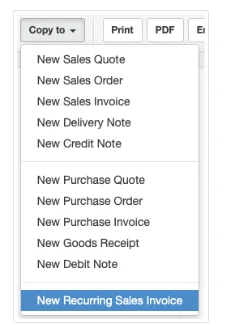Recurring Sales Invoices
Manager Settings > Recurring Transactions

Recurring Sales Invoices
Set up and manage recurring sales invoices
Recurring sales invoices are useful if your business routinely issues similar sales invoices to customers. Once you have set them up, Manager will notify you they are ready to be created when they come due at the prescribed intervals. Recurring sales invoices are often used for:
- Customer subscriptions
- Monthly service billings
- Organizational memberships and dues
- Rent due notices
Set up a recurring sales invoice
There are two methods for setting up recurring sales invoices.
First method
The first method for creating a new recurring sales invoice is to go to the Settings tab and click Recurring Sales Invoices:

Then click New Recurring Sales Invoice:

Second method
The second method is to use the Copy to function while viewing an existing sales invoice you want to make recurring:

For either method
Whichever way you begin, enter Next issue date to establish when the first recurring invoice will be created:

If desired, enter the number of days after the issue date of the optional Due Date. If nothing is entered, Manager will assign the issue date as the due date:

Select an Interval to control how often this recurring invoice will be created:

Select whether the recurring invoice will be good Until further notice or until a Custom date. If Custom is selected, a calendar date picker will appear:

Enter remaining information as if creating a regular sales invoice and click Create. On the Recurring Sales Invoices screen, Next issue date will be updated based on the selected Interval. Termination date (if set) will also be shown:

Note
Recurring sales invoices in Manager are templates from which actual sales invoices will be generated later. Setting up a recurring sales invoice does not affect your customer balances, customer statements, inventory, income, or expenses. In fact, while Manager will notify you recurring invoices are pending, it will not automatically generate them for you. This avoids problems if you need to edit an invoice before issuing it or you forget to enter a service modification.
Recurring sales invoices in Manager are templates from which actual sales invoices will be generated later. Setting up a recurring sales invoice does not affect your customer balances, customer statements, inventory, income, or expenses. In fact, while Manager will notify you recurring invoices are pending, it will not automatically generate them for you. This avoids problems if you need to edit an invoice before issuing it or you forget to enter a service modification.
Generate invoices
When one or more recurring sales invoices are due (or past due) to be issued, two notifications are provided. The first is a yellow counter window in the left navigation pane showing the number of recurring invoices for which invoices are pending (not the number of pending invoices, which could be higher if you have not kept up by creating invoices that are due):

The second notification occurs any time you go to the Sales Invoices tab. You will see a yellow banner notice that at least one recurring invoice is pending:
Click on the yellow bar to review invoices to be generated. Select all pending recurring invoices by checking the top box. Or, select individual recurring invoices. Then click Batch Create:

The next recurring invoice for each selection will be immediately created under the Sales Invoices tab. You can further Edit or View it without affecting future recurring invoices:

Note
When you view an invoice directly in the Sales Invoices tab, you are viewing it as a standard invoice, not a recurring invoice. Any changes you make to it will not affect the recurring sales invoice defined in the Settings tab.
When you view an invoice directly in the Sales Invoices tab, you are viewing it as a standard invoice, not a recurring invoice. Any changes you make to it will not affect the recurring sales invoice defined in the Settings tab.
When you create an invoice from the recurring sales invoice selection screen, only one invoice is created at a time. If more than one invoice is due from the same recurring invoice (because you fell behind), the date in the Next issue date column will change according to the interval defined for the recurring invoice. Selecting that recurring invoice and clicking Batch Create again will generate an additional standard invoice. Repeat this process until the recurring sales invoice is grayed out on screen.
While you are selecting recurring invoices, you can also edit them. Click the Edit button to go to the recurring invoice definition screen.
Caution
Edits made during the selection process affect the recurring invoice itself, not the standard invoice you are generating from it. Therefore, all future sales invoices created from the recurring sales invoice will reflect the changes made during the editing process, including any invoice you create immediately. So, if you want to change only the current invoice you are creating, click Batch Create first and edit the resulting invoice in the Sales Invoices tab.
Edits made during the selection process affect the recurring invoice itself, not the standard invoice you are generating from it. Therefore, all future sales invoices created from the recurring sales invoice will reflect the changes made during the editing process, including any invoice you create immediately. So, if you want to change only the current invoice you are creating, click Batch Create first and edit the resulting invoice in the Sales Invoices tab.
Cancel a recurring invoice
When circumstances change, such as when a customer cancels a subscription, you may want to cancel future recurring invoices. Click Edit for the recurring invoice in Settings, then Delete:

The recurring invoice will be removed from the list and no new invoices will be created from it. Cancelled recurring invoices cannot be restored. They must be recreated from scratch.
Skip an invoice
If recurring invoices must be skipped, but routine invoicing will resume in the future, click Edit for the recurring invoice in Settings. Set a new Next issue date, then click Update to save the change.
Example
Your customer’s next recurring sales invoice for monthly service should be generated on 15 July 2021:
Your customer’s next recurring sales invoice for monthly service should be generated on 15 July 2021:

Your customer pauses the service subscription for one month; therefore, no invoice should be issued on 15 July. The next invoice should be issued on 15 August, so you edit the recurring sales invoice in Settings and click Update:

You now see the next sales invoice is due 15 August:

